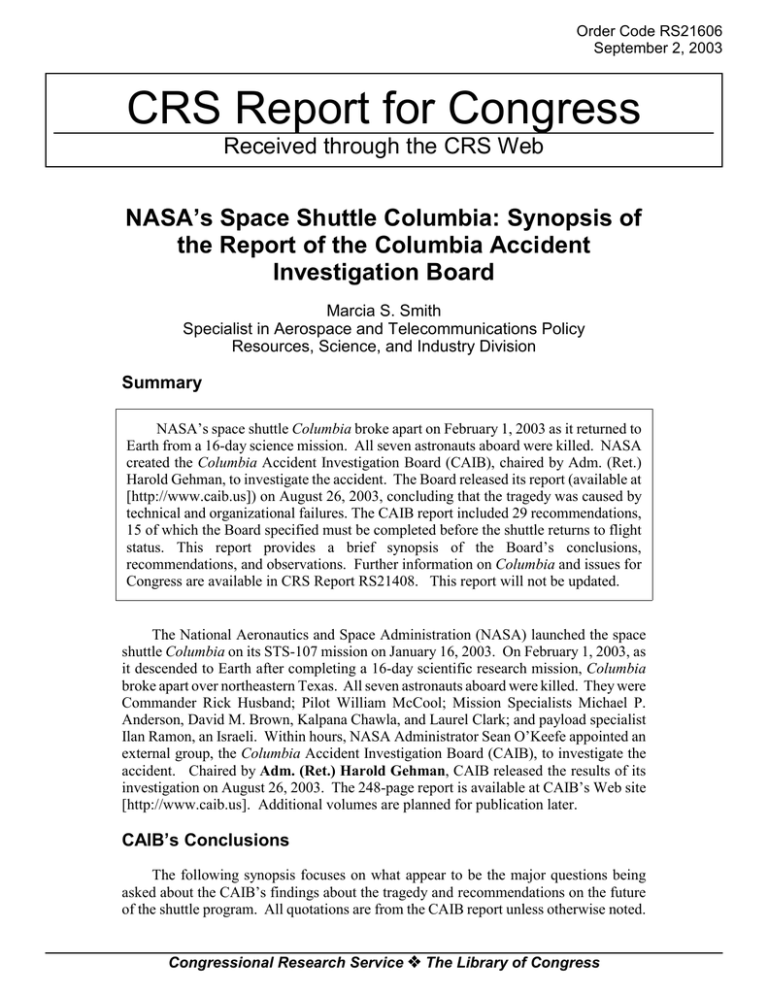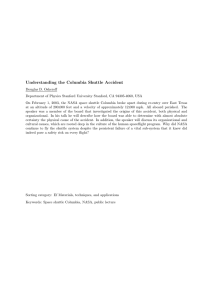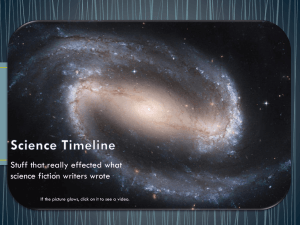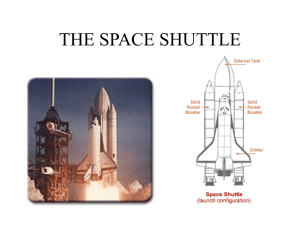CRS Report for Congress NASA’s Space Shuttle Columbia: Synopsis of Investigation Board
advertisement

Order Code RS21606 September 2, 2003 CRS Report for Congress Received through the CRS Web NASA’s Space Shuttle Columbia: Synopsis of the Report of the Columbia Accident Investigation Board Marcia S. Smith Specialist in Aerospace and Telecommunications Policy Resources, Science, and Industry Division Summary NASA’s space shuttle Columbia broke apart on February 1, 2003 as it returned to Earth from a 16-day science mission. All seven astronauts aboard were killed. NASA created the Columbia Accident Investigation Board (CAIB), chaired by Adm. (Ret.) Harold Gehman, to investigate the accident. The Board released its report (available at [http://www.caib.us]) on August 26, 2003, concluding that the tragedy was caused by technical and organizational failures. The CAIB report included 29 recommendations, 15 of which the Board specified must be completed before the shuttle returns to flight status. This report provides a brief synopsis of the Board’s conclusions, recommendations, and observations. Further information on Columbia and issues for Congress are available in CRS Report RS21408. This report will not be updated. The National Aeronautics and Space Administration (NASA) launched the space shuttle Columbia on its STS-107 mission on January 16, 2003. On February 1, 2003, as it descended to Earth after completing a 16-day scientific research mission, Columbia broke apart over northeastern Texas. All seven astronauts aboard were killed. They were Commander Rick Husband; Pilot William McCool; Mission Specialists Michael P. Anderson, David M. Brown, Kalpana Chawla, and Laurel Clark; and payload specialist Ilan Ramon, an Israeli. Within hours, NASA Administrator Sean O’Keefe appointed an external group, the Columbia Accident Investigation Board (CAIB), to investigate the accident. Chaired by Adm. (Ret.) Harold Gehman, CAIB released the results of its investigation on August 26, 2003. The 248-page report is available at CAIB’s Web site [http://www.caib.us]. Additional volumes are planned for publication later. CAIB’s Conclusions The following synopsis focuses on what appear to be the major questions being asked about the CAIB’s findings about the tragedy and recommendations on the future of the shuttle program. All quotations are from the CAIB report unless otherwise noted. Congressional Research Service ˜ The Library of Congress CRS-2 What Caused the Columbia Accident? The Board “recognized early on that the accident was probably not an anomalous, random event, but rather likely rooted to some degree in NASA’s history and the human space flight program’s culture.” (p. 9) Therefore, it also looked at “political and budgetary considerations, compromises, and changing priorities over the life” of the shuttle program, and “places as much weight on these causal factors as on the ... physical cause....” (p. 9) The physical cause was damage to Columbia’s left wing by a 1.7 pound piece of insulating foam that detached from the left “bipod ramp” that connects the External Tank1 to the orbiter, and struck the orbiter’s left wing 81.9 seconds after launch. The foam strike created a hole in a Reinforced Carbon-Carbon (RCC) panel on the leading edge of the wing, allowing superheated air (perhaps exceeding 5,000oF) to enter the wing during reentry. The extreme heat caused the wing to fail structurally, creating aerodynamic forces that led to the disintegration of the orbiter. (Described in detail in Chapters 2 and 3.) Regarding organizational causes, the Board concluded the accident was — ... rooted in the Space Shuttle Program’s history and culture, including the original compromises that were required to gain approval for the Shuttle, subsequent years of resource constraints, fluctuating priorities, schedule pressures, mischaracterization of the Shuttle as operational rather than developmental, and lack of an agreed national vision for human space flight. Cultural traits and organizational practices detrimental to safety were allowed to develop, including: reliance on past success as a substitute for sound engineering practices..., organizational barriers that prevented effective communication of critical safety information and stifled professional differences of opinion; lack of integrated management across program elements; and the evolution of an informal chain of command and decision-making processes that operated outside the organization’s rules. (p. 9) The Board found that there is a “broken safety culture” at NASA (pp. 184-189). Schedule pressure (pp. 131-139) related to construction of the International Space Station, budget constraints (pp. 102-105), and workforce reductions (pp. 106-110) also were factors. The Board concluded that the shuttle program “has operated in a challenging and often turbulent environment....” (p. 118) “It is to the credit of Space Shuttle managers and the Shuttle workforce that the vehicle was able to achieve its program objectives for as long as it did.” (p. 119) Should the Shuttle Continue to Fly? The Board concluded that “the present Shuttle is not inherently unsafe” but the “observations and recommendations in this report are needed to make the vehicle safe enough to operate in the coming years.” (p. 208) CAIB “supports return to flight for the Space Shuttle at the earliest date consistent with an 1 The Space Transportation System (STS)—the space shuttle—consists of an airplane-like Orbiter, two Solid Rocket Boosters (SRBs) on either side, and a large cylindrical External Tank that holds cryogenic fuel for the Orbiter’s main engines. The SRBs detach from the orbiter 2 ½ minutes after launch when their fuel is spent, fall into the ocean, and are recovered for refurbishment and reuse. The External Tank is not reused. It is jettisoned as the Orbiter reaches Earth orbit, and disintegrates as it falls into the Indian Ocean. CRS-3 overriding consideration: safety.” (p. 208) NASA has a target of March/April 2004 for return to flight, and Adm. Gehman stated in an interview on PBS’ The NewsHour with Jim Lehrer on August 26 that he saw no reason why NASA could not meet that schedule. The CAIB report contains 29 recommendations (listed below)—23 technical and six organizational—of which 15 must be implemented before the shuttle returns to flight status. The others are “continuing to fly” recommendations assuming the shuttle will be used for years to come. The Board recommended that, if the shuttle is to be used beyond 2010, that it be recertified (p. 209). But the Board said it reached an “inescapable conclusion”— Because of the risks inherent in the original design of the Space Shuttle, because the design was based in many aspects on now-obsolete technologies, and because the Shuttle is now an aging system but still developmental in character, it is in the nation’s interest to replace the Shuttle as soon as possible as the primary means for transporting humans to and from Earth orbit. (p. 210-211. Emphasis in original.) Why Did NASA Decide Not to Obtain Imagery from DOD Satellites to Assess the Damage? A central question during the investigation was why NASA did not ask the Department of Defense (DOD) to image the shuttle with its high resolution ground- or space-based systems to help assess whether the orbiter had been damaged by the foam. The Board found (pp. 140-172) that three requests for imagery were made by NASA engineers but through incorrect channels, plus there were several “missed opportunities”when managers could have pursued the issue. One request did reach the appropriate DOD personnel, but NASA canceled the request 90 minutes later. The Board concluded that the likely sequence of events was that the chair of STS-107’s Mission Management Team (MMT), after informally learning that there had been a “request” for imagery, called three other MMT members and determined that none knew of a “requirement” for imagery. CAIB cited a flawed analysis of the extent to which the orbiter might have been damaged by the foam that was too readily accepted by program managers, a low level of concern by program managers, a lack of clear communication, a lack of effective leadership, and a failure of the role of safety personnel as reasons why the imagery was not obtained. Whether such images would, in fact, have shown the damage remains unclear, but the Board recommended that such images now be taken on all shuttle missions. Could the Crew Have Been Saved? The Board concluded that the crew died from “blunt trauma and hypoxia” (lack of oxygen) after the crew cabin separated from the rest of the disintegrating shuttle and, itself, disintegrated; there was no explosion. (p. 77) The Board asked NASA to evaluate two options for returning the crew safely if the degree of damage had been understood early in the mission: repairing the damage on-orbit, or rescuing the crew with another shuttle mission. The repair option “while logistically viable....relied on so many uncertainties that NASA rated this option ‘high risk.’” (p. 173) The rescue option “was considered challenging but feasible.” (p. 174) What Are the “Echoes” of Challenger? Former shuttle astronaut Sally Ride served on the Rogers Commission that investigated the January 1986 Challenger accident, which claimed the lives of seven astronauts, and on CAIB. During the Columbia investigation, she said she heard “echoes” of Challenger as it became clear that the accident resulted from NASA failing to recognize that a technical failure (bipod ramp foam shedding) that had occurred on previous shuttle flights could have safety-of-flight implications even if the earlier missions were completed successfully. In the case of CRS-4 Challenger, it was erosion of seals (O-rings) between segments of the Solid Rocket Booster, which had been noted on previous missions. Some engineers warned NASA not to launch Challenger that day because unusually cold weather could have weakened the resiliency of the O-rings. They were overruled. CAIB concluded that “both accidents were ‘failures of foresight’” and the parallels between them demonstrate that: “the causes of the institutional failure responsible for Challenger have not been fixed”; “if these persistent, systemic flaws are not resolved, the scene is set for another accident”; and that while individuals must be accountable for their actions, “NASA’s problems cannot be solved simply by retirements, resignations, or transferring personnel.” (p. 195) CAIB’s Recommendations and Observations CAIB’s 29 recommendations are compiled in Chapter 11 of its report. Adm. Gehman stated at the Board’s August 26 press conference that there is no hierarchy in the recommendations—all have equal weight. The Board also made 27 “observations” in Chapter 10. Following are abbreviated versions of the recommendations—separated into those that must be implemented prior to Return to Flight, and those that are “continuing to fly” recommendations—and observations. Some have been combined for brevity. Return to Flight (RTF) Recommendations. CAIB recommends that NASA: • • • • • • • • • • • • • • initiate an aggressive program to eliminate all External Tank foam shedding; initiate a program to increase the orbiter’s ability to sustain minor debris damage; develop and implement a comprehensive inspection plan to assess the structural integrity of the RCC panels, supporting structure, and attaching hardware; develop a practical capability to inspect and effect emergency repairs to the orbiter’s thermal protection system (TPS) both when near the International Space Station and when operating away from it, and accomplish an on-orbit TPS inspection; upgrade the ability to image the shuttle during its ascent to orbit; obtain and downlink high resolution images of the External Tank after it separates from the orbiter, and of certain orbiter thermal protection systems; ensure that on-orbit imaging of each shuttle flight by Department of Defense satellites is a standard requirement; test and qualify “bolt catchers” used on the shuttle; require that at least two employees attend final closeouts and intertank area handspraying procedures when applying foam to the External Tank; require NASA and its contractors to use the industry-standard definition of “foreign object debris”; adopt and maintain a shuttle flight schedule that is consistent with available resources; implement an expanded training program for the Mission Management Team; prepare a detailed plan for creating an independent Technical Engineering Authority, independent safety program, and reorganized space shuttle integration office; and develop an interim program of closeout photographs for all critical sub-systems that differ from engineering drawings. Continuing to Fly Recommendations. The Board recommends that NASA: • increase the orbiter’s ability to reenter the atmosphere with minor leading edge damage to the extent possible; CRS-5 • • • • • • • • • • • • develop a better database to understand the characteristics of Reinforced CarbonCarbon (RCC) by destructive testing and evaluation; improve the maintenance of launch pad structures to minimize leaching of zinc primer onto RCC; obtain sufficient RCC panel spares so maintenance decisions are not subject to external pressures relating to schedules, costs, or other considerations; develop, validate, and maintain physics-based computer models to evaluate Thermal Protection System damage from debris impacts; maintain and update the Modular Auxiliary Data System (MADS) on each orbiter to include current sensor and data acquisition technologies, and redesign the MADS so they can be reconfigured during flight; develop a state-of-the-art means to inspect orbiter wiring; operate the shuttle with the same degree of safety for micrometeoroid and orbital debris as is used in the space station program, and change guidelines to requirements; establish an independent Technical Engineering Authority that is responsible for technical requirements and all waivers to them, which should be funded directly from NASA Headquarters and have no connection to or responsibility for schedule or program cost; give direct line authority over the entire shuttle safety organization to the Headquarters Office of Safety and Mission Assurance, which should be independently resourced; reorganize the Space Shuttle Integration Office to make it capable of integrating all elements of the Space Shuttle Program, including the Orbiter; develop and conduct a vehicle recertification prior to operating the shuttle beyond 2010 and include recertification requirements in the Shuttle Life Extension Program; and provide adequate resources for a long-term program to upgrade shuttle engineering drawings. Observations. Chapter 10 lists 27 observations—“significant issues that are potentially serious matters that should be addressed ... because they fall into the category of ‘weak signals’ that could be indications of future problems.” Therefore, NASA should: • • • • • • develop and implement a public risk acceptability policy for launch and reentry of space vehicles and unmanned aircraft; develop and implement a plan to mitigate the risk that shuttle flights pose to the general public; study the Columbia debris to facilitate realistic estimates of the risk to the public during orbiter reentry; incorporate knowledge gained from Columbia in requirements for future crewed vehicles in assessing the feasibility of vehicles that could ensure crew survival even if the vehicle is destroyed; perform an independent review of the Kennedy Space Center (KSC) Quality Planning Requirements Document to address the quality assurance program and its administration, consolidate KSC’s Quality Assurance programs under one Mission Assurance Office that reports to the Center Director, require quality assurance managers to work with NASA and perhaps DOD to develop training programs, and examine which areas of ISO 9000/9001 truly apply to a 20-year old research and development system like the space shuttle; use statistical sampling for Quality and Engineering review of work documents for the next shuttle flight (STS-114); CRS-6 • • • • • • • • • • • • • • • implement United Space Alliance’s (USA’s) suggestions for process improvement; create an oversight process to statistically sample the work performed by USA technicians to ensure process control, compliance, and consistency; make every effort to achieve greater stability, consistency, and predictability in Orbiter Major Modification planning, scheduling, and work standards; better understand workforce and infrastructure requirements, match them against capabilities, and take actions to avoid exceeding thresholds; continue to work with the Air Force on aging systems, service life extension, planning and scheduling, workforce management, training, and quality assurance; determine how the shuttle program office will meet the challenges of inspecting and maintaining an aging shuttle fleet; include non-destructive analysis of the potential impacts on structural integrity when evaluating corrosion damage, make long-term corrosion detection a funding priority, develop non-destructive inspections to find hidden corrosion, and establish orbiterspecific corrosion rates for orbiter-specific environments; do not use Teflon and Molybdenum Disulfide in the carrier panel bolt assembly; mitigate galvanic coupling between aluminum and steel alloys; review the use of Room Temperature Vulcanizing 560 and Koropon; assure the continued presence of compressive stresses in A-286 bolts in their acceptance and qualification procedures; consider a redesign of the “hold-down” bolt system; reinstate a safety factor of 1.4 for the solid rocket booster attachment rings; assess whether upgrading to digital test equipment will provide the reliability and accuracy needed to maintain the shuttle through 2020; and implement an agency-wide strategy for leadership and management training that provides a more consistent and integrated approach to career development. General Deal’s Supplemental Views Air Force Brig. Gen. Duane Deal, a CAIB member, wrote a “supplement” that is scheduled to be published in Volume II as Appendix D. Some of the views in the supplement were reported by the media on August 27. CAIB supplied a copy of the document to CRS, emphasizing that it represents supplemental, not dissenting, views. Gen. Deal expressed concern that NASA may not fully implement the CAIB’s recommendations, and particularly its observations. “History shows that NASA often ignores strong recommendations; without a culture change, it is overly optimistic to believe NASA will tackle something relegated to an ‘observation’ when it has a record of ignoring recommendations.” He said the supplement is written from the perspective of someone “who fears the [CAIB] report has bypassed some items that could prevent ‘the next accident’ from occurring—the ‘next’ O-ring or the ‘next’ bipod ramp.” He believes the observations should have been characterized as “‘strong signals’ that are indications of present and future problems” rather than “weak signals” that could indicate future problems. Among the areas he listed as needing further attention are: Quality Assurance (unresponsive management, staffing levels, grade levels, inspector qualifications, employee training, providing necessary tools, government inspections, and quality program surveillance); Orbiter Corrosion; Solid Rocket Booster External Tank Attach Ring; Crew Survivability; Shiftwork and Overtime; security of Redesigned Solid Rocket Motors when they are shipped from the manufacturer; and security at NASA’s Michoud Assembly Facility where the External Tanks are assembled.





